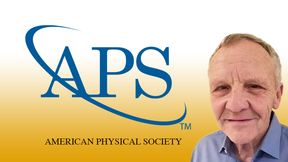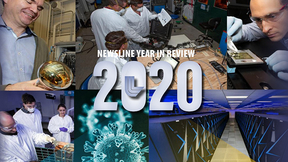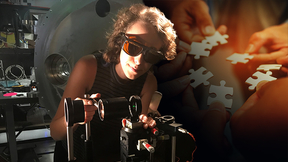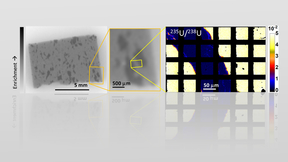Back
Global Security
Army reservists a vital part of Lab’s workforce
Lawrence Livermore National Laboratory (LLNL) joins in the celebration of the U.S. Army birthday on June 14. Created in 1775, the army originally consisted of volunteer soldiers with roots to the Continental Army — and was formed to fight the Revolutionary War. Today, as the largest branch of the country’s military, the proud men and women of the U.S. Army continue to…
Advanced Data Analytics for Proliferation Detection shares technical advances during two-day meeting
The Advanced Data Analytics for Proliferation Detection (ADAPD) program held a two-day virtual technical exchange meeting recently. The goal of the meeting was to highlight the science-based and data-driven analysis work conducted by ADAPD to advance the state-of-the-art to accelerate artificial intelligence (AI) innovation and develop AI-enabled systems to enhance the…
Lawrence Livermore takes part in international planetary defense conference
Ten scientists from Lawrence Livermore National Laboratory (LLNL) last week took part in the 7th IAA Planetary Defense Conference (PDC), hosted by the United Nations Office for Outer Space Affairs in cooperation with the European Space Agency. Megan Bruck Syal, who helped lead the Lab’s participation in the event and who also was a conference session chair, said this year…
Different neutron energies enhance asteroid deflection
A research collaboration between Lawrence Livermore National Laboratory (LLNL) and the Air Force Institute of Technology (AFIT) investigates how the neutron energy output from a nuclear device detonation can affect the deflection of an asteroid. Scientists compared the resulting asteroid deflection from two different neutron energy sources, representative of fission and…
LLNL researchers and business development executives capture best-ever three technology transfer awards
Researchers from Lawrence Livermore National Laboratory (LLNL) and their colleagues who help them commercialize technologies have won three national technology transfer awards this year. The trio of awards, from the Federal Laboratory Consortium (FLC), represent the most national awards that LLNL has ever won in one year’s competition over the past 36 years. Two of the…
Dreicer garners NNSA Gold Award
When Mona Dreicer learned she had been tapped to receive one of the National Nuclear Security Administration’s (NNSA) top awards, she had two reactions – she was surprised and she was honored. The deputy director of the Lab’s Center for Global Security Research (CGSR) for six years until her retirement in 2020, Dreicer has been named a recipient of the NNSA Administrator’s…
Ten-year anniversary of Fukushima observed
Ten years ago today, on March 11, 2011, a 9.0 Richter-scale earthquake and tsunami in Japan resulted in severe damage to the Fukushima Dai-ichi nuclear power plant and also led to releases of radioactivity into the environment. That same day, the U.S. Department of Energy (DOE) activated Lawrence Livermore National Laboratory’s National Atmospheric Release Advisory Center …
LLNL and NPS ink MOU for collaboration
Whether working informally or through a collaboration agreement, Lawrence Livermore National Laboratory (LLNL) and the Monterey-based Naval Postgraduate School (NPS) have enjoyed an enduring relationship for more than two decades. While the two institutions have worked together informally for years, until recently they had only one memorandum of understanding (MOU)…
Lab launches interdisciplinary Space Science Institute
What are the next world-class, game-changing concepts and technologies that will address the most important questions in astrophysics or planetary science? Lawrence Livermore National Laboratory (LLNL) researchers will soon be better equipped to answer this question with the launch this month of a new Space Science Institute (SSI), intended to boost cross-discipline…
Retiring Director Bill Goldstein leaves behind a rich legacy of extraordinary growth, innovation for the Lab
Nearly a year into piloting a major scientific institution through one of the most taxing and disruptive global events in modern history, outgoing Livermore Lab Director Bill Goldstein is ready for a vacation. One of Goldstein’s first orders of business following his retirement on March 1 is returning to the lush slopes, coffee plantations and sandy beaches of Kona, Hawaii…
Tarver honored with American Physical Society award
Craig Tarver, a Lawrence Livermore National Laboratory (LLNL) retiree and consultant to the Lab’s Energetic Materials Center, has been honored with the American Physical Society’s (APS) 2021 George E. Duvall Shock Compression Science Award for “theoretical advancement of the understanding of shock-driven reactions and detonation in condensed phase explosives.” Since 1987,…
LLNL Weapon Engineers, Biologists Deliver Critical Samples to Identify Skin Proteins Left on IEDs
Following a terrorist bombing, can the bomb maker be identified by skin proteins left on the bomb components they handled? To address this question, Lawrence Livermore National Laboratory (LLNL) personnel from Weapons Complex Integration (WCI) and Global Security (GS) Forensic Science and Biosecurity Centers (FSC/BSC) subjected notional bomb components handled by LLNL…
LLNL weapon engineers, biologists deliver critical samples to identify skin proteins left on IEDs
Following a terrorist bombing, can the bomb maker be identified by skin proteins left on the bomb components they handled? To address this question, Lawrence Livermore National Laboratory (LLNL) personnel from Weapons Complex Integration (WCI) and Global Security (GS) Forensic Science and Biosecurity Centers (FSC/BSC) subjected notional bomb components handled by LLNL…
Lab publishes fourth ‘Strategic Latency Unleashed’ book
The Lawrence Livermore National Laboratory's (LLNL) Center for Global Security Research (CGSR) has published the fourth book in its Strategic Latency series — "Strategic Latency Unleashed: The Role of Technology in a Revisionist Global Order and the Implications for Special Operations Forces." Previous volumes in the Latency series have examined the effects of emerging…
Kim Budil selected as director of Lawrence Livermore
Kim Budil has been named director of Lawrence Livermore National Laboratory (LLNL). Charlene Zettel, chair of Lawrence Livermore National Security, LLC (LLNS), which manages the Laboratory for the Department of Energy's (DOE) National Nuclear Security Administration (NNSA), made the announcement to Laboratory employees Jan. 28. Budil will begin her new role on March 2…
Lawrence Livermore's '2020 Year in Review'
Though 2020 was dominated by events surrounding the COVID-19 pandemic — whether it was adapting to social distancing and the need to telecommute, safeguarding employees as they returned to conduct mission-essential work or engaging in COVID-related research — Lawrence Livermore National Laboratory (LLNL) managed an exceptional year in all facets of science and technology…
Lab's ACT-UP awards focus on collaborative research
With a focus on increasing joint research efforts between Lawrence Livermore National Laboratory (LLNL) and universities, the Lab’s Weapon Physics and Design (WPD) Academic Collaboration Team (ACT) University Program has awarded this year’s ACT-UP awards. Now in its second year, the ACT-UP awards were created to encourage and advance strategic partnerships among…
Lab's ACT-UP awards focus on collaborative research
With a focus on increasing joint research efforts between Lawrence Livermore National Laboratory (LLNL) and universities, the Lab’s Weapon Physics and Design (WPD) Academic Collaboration Team (ACT) University Program has awarded this year’s ACT-UP awards. Now in its second year, the ACT-UP awards were created to encourage and advance strategic partnerships among…
Lab analysis reveals forensic signatures of nuclear material during international smuggling exercise
Lawrence Livermore National Laboratory (LLNL) scientists received mock evidence, consisting of two uranium oxide (UO2) fuel pellets, as part of an international nuclear forensic exercise in support of a simulated nuclear smuggling investigation. The exercise was part of the CMX-5 Collaborative Materials Exercise organized by the Nuclear Forensics International Technical…
Former intern, a 'Voice for Tomorrow,' wins Rieser award
A former intern from Lawrence Livermore National Laboratory's (LLNL's) Center for Global Security Research (CGSR) has been named the recipient of the 2020 Leonard Rieser Award from the Bulletin of the Atomic Scientists. Jake Tibbetts, who worked as a research associate at CGSR from May 2019 to May 2020, won the honor for a “Voices of Tomorrow” essay he wrote for the…
























